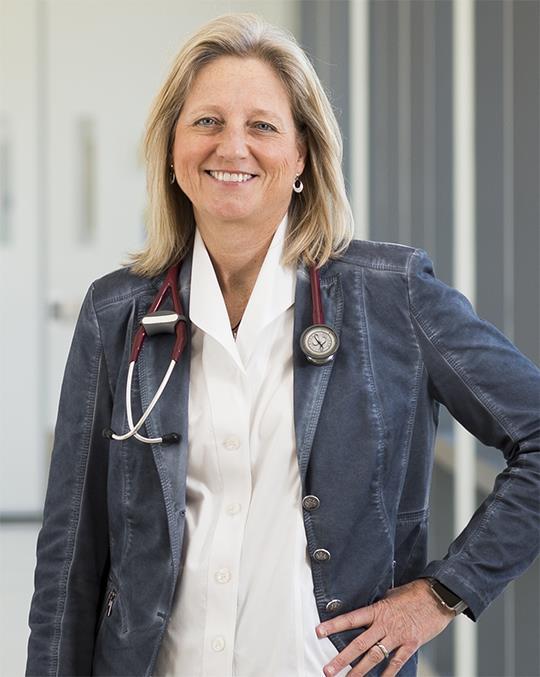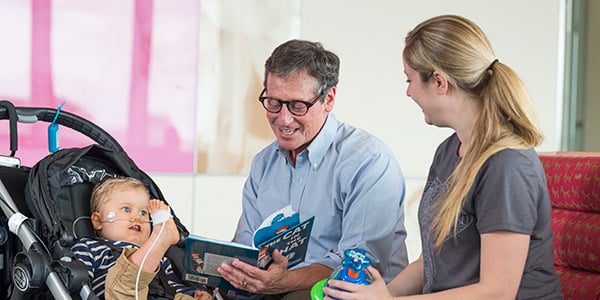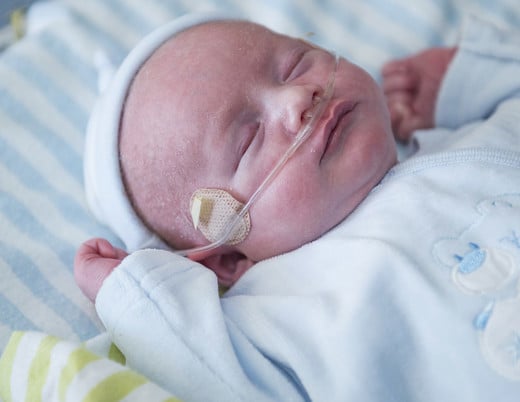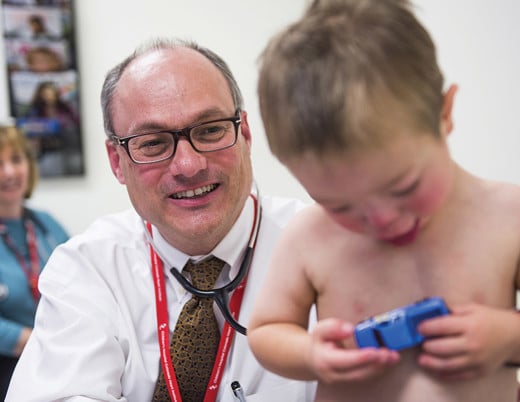Twenty-five years after pioneering the use of inhaled nitric oxide to treat newborns with pulmonary hypertension (PH), pediatric pulmonologist Steve Abman, MD, is on his biggest mission yet: preventing and curing the chronic lung disease of premature newborns known as bronchopulmonary dysplasia (BPD).
His approach is to blend laboratory and clinical research strategies to learn new methods of improving how the lung's blood vessels grow and function in premature infants to prevent PPHN and preserve normal lung growth.
Dr. Abman's research improves outcomes for patients with BPD, PH and more
With the Pediatric Heart Lung Center team of investigators, Dr. Abman is currently studying how events before birth determine vascular health and disease later in life. His animal models of BPD have identified new mechanisms causing BPD that may lead to clinical trials.
He also is conducting studies to find the earliest predictors of BPD in premature infants. Through clinical features and biomarkers, the team hopes to identify early events and target them with specific therapies, such as increasing the growth factors that cause blood vessels to form.
"If you enhance how the blood vessels grow in the lung and restore normal function of those blood vessels, we believe that you can optimize growth of the airspaces in the lungs as well," Dr. Abman says.
Better care for PH and BPD around the world
Dr. Abman's vision to cure BPD — and all forms of PH, for that matter — extends well beyond Colorado. To better share data and research among all caregivers, Dr. Abman founded PPHNet, an organization of 10 healthcare sites across North America. This collaborative is currently developing a patient registry that will integrate data from electronic health records to learn more about patient histories, outcomes and treatment responses for various kinds of pediatric PH.
"Clinical care is not isolated from discoveries in the lab," Dr. Abman says. "Improving outcomes is all about getting folks with diverse backgrounds together to blend clinical experience and laboratory knowledge to develop new and effective therapeutic approaches."
In recognition of Dr. Abman's contributions to the study of lung disease in the newborn and premature infant, Dr. Abman received the International Arvo Ylppö Medal Award in October 2017 in Helsinki. This honor is awarded from the Chairmen of Pediatrics of the five Finnish medical schools, the Finnish Pediatric Associate, the Foundation for Pediatric Research in Finland and the Mannerheim League for Child Welfare. Dr. Abman donated the award funds to the PHLC to help support research expenses for residents, fellows and junior faculty.
"Steve Abman is one of the foremost pioneers and a giant in the field of pediatric pulmonology," says Robin Deterding, MD, Medical Director of the Breathing Institute. "Through translational research, clinical care and education, he has improved care for children with pulmonary hypertension and chronic lung disease of prematurity, here in Colorado and around the world."
Multidisciplinary care for ventilator-dependent patients
Historically, care for ventilator-dependent BPD patients has taken place in acute care settings, where critical care providers may have less experience with the complexities of managing a chronic population. And infants with BPD are at risk for a host of potential adverse outcomes — PH, gastroesophageal reflux, feeding difficulty, airway disease, retinopathy of prematurity, systemic hypertension and neurodevelopmental impairment.
The many comorbidities of ventilator-dependent BPD add complexity to the course of care and can make communication more difficult, potentially opening gaps in care. In fact, the Breathing Institute team at Children's Colorado speculated that communication problems and care gaps might be the two most important factors to increased morbidity and mortality.
A standardized approach to long-term ventilator care
The Ventilator Care Program at Children's Colorado was formed in 2006 by a multidisciplinary team including Dr. Abman, pediatric pulmonologist Christopher Baker, MD, and neonatologist Jason Gien, MD. As members of the Center, they sought to improve care continuity and communications by standardizing approaches to those multisystem morbidities, toward the goal of improving survival.
Patients who require ventilators account for some of the lengthiest, most expensive hospital stays — the average over 2011 and 2012 was 249 days, Dr. Baker found. "And there were plenty of kids in the hospital for over a year."
The team started with weekly multidisciplinary bedside rounds, in order allow nurses, therapists and family to express concerns, and to facilitate the primary team and subspecialists in formulating a collaborative care plan.
From there, the team assessed common contributors to morbidity and mortality in the patient population and implemented screening and a coordinated treatment approach for PH. The team also addressed reflux and aspiration — common comorbidities of BPD — with fundoplication, a surgical procedure to treat gastroesophageal reflux disease, and placing gastronomy tubes in all infants. These efforts resulted in shorter hospital stays and lower costs.
Better outcomes and survival for ventilator-dependent BPD
Breathing Institute researchers, led by Dr. Baker, now Medical Director of the Ventilator Care Program, and Dr. Gien, the program's co-director and the study's principal investigator, performed a retrospective chart review for all patients in the Children's Colorado NICU who underwent tracheostomy placement for severe BPD. They collected data for 14 years split into two periods: before the Ventilator Care Program, and after.
Their conclusion: The program had vastly improved outcomes and survival for ventilator-dependent BPD patients. Survival to discharge for these very high-risk infants increased from 50 to 85%.
Read the full article, Retrospective Analysis of an Interdisciplinary Ventilator Care Program Intervention on Survival of Infants with Ventilator-Dependent Bronchopulmonary Dysplasia, published in the June 2016 issue of the American Journal of Perinatology.
Independence for ventilator-dependent patients and families
Sending a child home with chronic ventilation involves staggering logistics: training for parents and caregivers, coordination between multiple agencies and high-stakes decisions about the child's stability. Dr. Baker and his team applied a business technique called process mapping to standardize these procedures, incorporating videos, handouts and novel training (like the high-fidelity simulation) into a coordinated model of ongoing care.
It's working. Average stays are down to 143 days, a drop of 43%, with fewer complications and readmissions, and zero fatalities.
And Dr. Baker's methodology, which results in significant cost reductions each year, may become the national standard: Pediatrics published his results in April of 2016.
The development and success of the Ventilator Care Program at Children's Colorado also played a significant role in forming the BPD Collaborative, a network of centers dedicated to improving long-term outcomes of premature infants with BPD. The group's initial work has established new guidelines of care.
Read the full article, "Interdisciplinary Care of Children with Severe Bronchopulmonary Dysplasia," published in The Journal of Pediatrics in February 2017.
Featured Researchers

Steve Abman, MD
Director, Pediatric Heart Lung Center
The Breathing Institute
Children's Hospital Colorado
Professor
Pediatrics-Pulmonary Medicine
University of Colorado School of Medicine

Robin Deterding, MD
Chief, Pediatric Pulmonary Medicine
The Breathing Institute
Children's Hospital Colorado
Professor
Pediatrics-Pulmonary Medicine
University of Colorado School of Medicine

Christopher Baker, MD
Director of the Ventilator Care Program
The Breathing Institute
Children's Hospital Colorado
Professor
Pediatrics-Pulmonary Medicine
University of Colorado School of Medicine

Jason Gien, MD
Neonatologist
Neonatal Intensive Care Unit
Children's Hospital Colorado
Professor
Pediatrics-Neonatology
University of Colorado School of Medicine





 720-777-0123
720-777-0123










